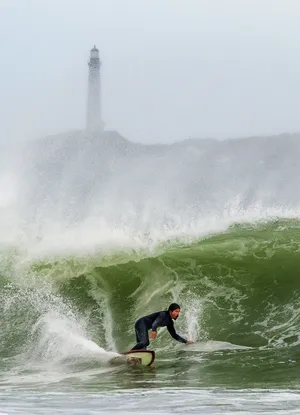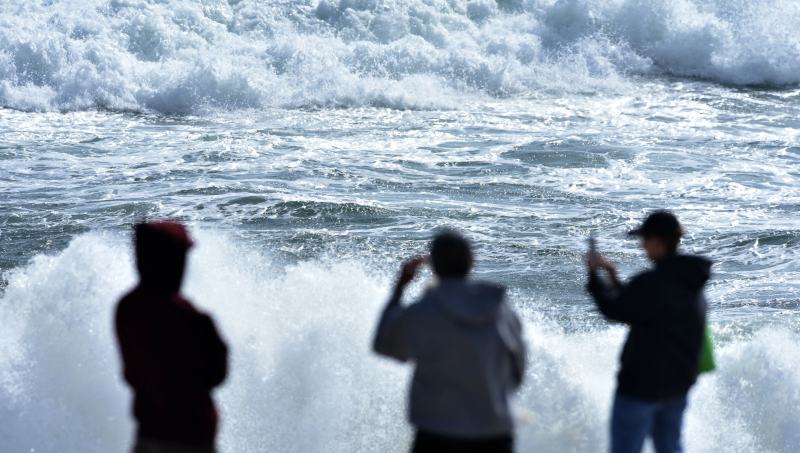Hurricane Lee fades, but 'life-threatening' surf persists for thousands of miles: Updates
More than 100,000 homes and businesses in Maine and eastern Canada were in the dark Sunday as wind gusts of up to 50 mph from the remnants of once-mighty Hurricane Lee buffeted the region.
Lee, once a Category 5 behemoth, has been downgraded to a post-tropical cyclone but still managed to sustain winds of 45 mph Sunday. The storm was centered about 135 miles west of Newfoundland and was racing to the northeast at 22 mph.
All tropical storm watches and warnings for New England and Canada were canceled Sunday.
Maine Gov. Janel Mills warned that high winds from the storm, combined with full canopy trees and saturated ground, meant downed trees would be a recurring problem. She urged residents to stay off the roads − and said those who must travel should avoid driving around downed trees or over downed wires and obey road closure signs and barriers.
A 51-year-old Maine man died Saturday after a large tree limb fell on his vehicle on a highway in Searsport, about 110 miles northeast of Portland. The limb downed live power lines, and utility workers had to cut power before removing the man, who died at a hospital, Police Chief Brian Lunt said.
Lee makes landfall in Canada:Impacts felt in New England: Power outages, downed trees
Developments:
◾ Forecasters said coastal flooding would subside Sunday and the storm could dissipate completely on Tuesday.
◾ The hurricane center named a new storm Saturday night. Tropical Storm Nigel, more than 1,000 miles east of Bermuda, was forecast to gain hurricane strength Monday. Nigel was not forecast to hit the U.S., AccuWeather said.

Hurricanes in New England? More could be on the way
Long-time New England residents are far more used to battening down for nor'easters than dealing with hurricane effects. But potent winds from Lee − once a Category 5 hurricane − that churned in the Atlantic near the New England coast have served as a reminder that powerful storms can still pose a threat, even in these comparatively cold, Northern waters.
That threat could be growing. Some studies suggest conditions could become more conducive to more hurricane winds in the region as climate change continues to unfold. Several studies also suggest hurricane activity and the potential for higher winds is likely to expand northward on a warming planet. Read more here.
− Dinah Voyles Pulver and Camille Fine
More storms coming?Hurricanes almost never hit New England. That could change as the Earth gets hotter.
Lee similar to Superstorm Sandy but less deadly
Lee shared some characteristics with the infamous Superstorm Sandy of 2012, among the largest hurricanes on record. Both storms were powerful hurricanes that became post-tropical cyclones before landfall. But while Sandy was blamed for dozens of U.S. deaths and more than 200 deaths in eight countries, Lee has thus far been blamed for one death in Florida and one in Maine.
Destructive hurricanes are rare for New England, although the Great New England Hurricane of 1938 brought gusts as high as 186 mph and sustained winds of 121 mph at Massachusetts’ Blue Hill Observatory. But there have been no storms that powerful in recent years, meteorologists say.
'Life-threatening' surf for thousands of miles
Very little additional damaging rain was forecast from Lee's remnants. But swells generated by Lee continue to affect thousands of miles of the Atlantic Coast. Large swells were reported in Puerto Rico, Hispaniola, the Turks and Caicos Islands, the Bahamas, Bermuda, the East Coast of the United States and Atlantic Canada, the hurricane center said.
"These swells are likely to cause life-threatening surf and rip current conditions," the center warned.
Hundreds of flights canceled because of Lee
Airport schedules in New England and Canada were beginning to normalize Sunday after Lee brought havoc to flying on Saturday. More than 230 flights into and out of Boston's Logan Airport were canceled and more than 100 delayed Saturday. Airports in Portland and Bangor, Maine, also had numerous delays and cancellations, as did Canadian airports in Toronto, Montreal and Halifax.
What's a post-tropical cyclone?
Lee completed its transition from a hurricane to a post-tropical cyclone Saturday morning, although it was still packing hurricane-force winds. A post-tropical cyclone is when a hurricane loses its tropical characteristics and becomes more "extra-tropical," associated with fronts and a larger wind field, said meteorologist Sara Johnson, with the National Weather Service in Gray/Portland, Maine. Post-tropical cyclones can still carry heavy winds and rains, the weather service says.
Contributing: Jeanine Santucci and Dinah Voyles Pulver, USA TODAY; The Associated Press

Disclaimer: The copyright of this article belongs to the original author. Reposting this article is solely for the purpose of information dissemination and does not constitute any investment advice. If there is any infringement, please contact us immediately. We will make corrections or deletions as necessary. Thank you.


